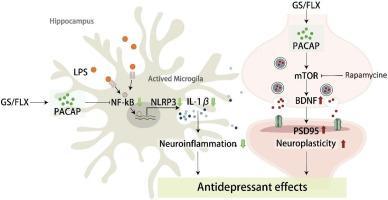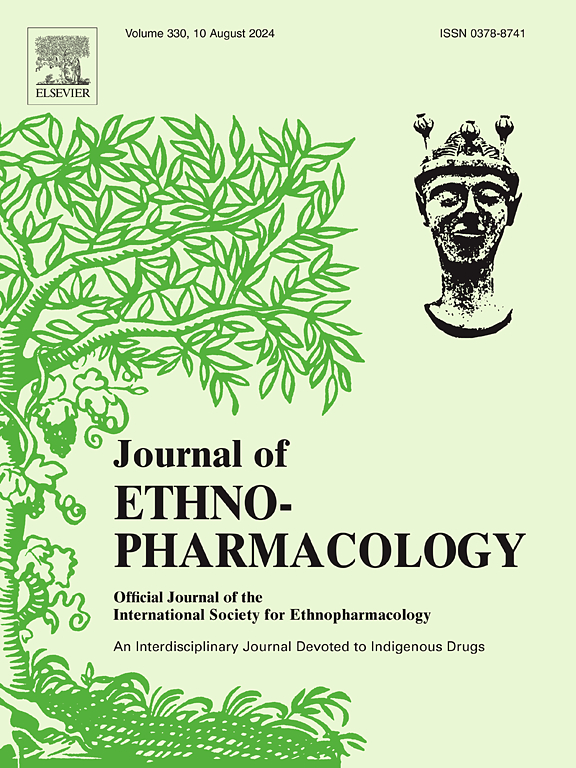在LPS诱导的抑郁模型中,与越剧处方剂量成比例的两种鸢尾类化合物混合物的慢性治疗可改善海马PACAP相关的神经炎症和神经可塑性信号传导。
IF 4.8
2区 医学
Q1 CHEMISTRY, MEDICINAL
引用次数: 0
摘要
民族药理学意义:京尼平苷(GP)和山慈菇苷甲酯(SM)是经典传统中药越鞠丸中的两种重要生物活性化合物,目前在中国被用作非处方药(OTC)。越鞠丸在处方剂量下具有类似抗抑郁剂的效果。由于GP和SM都具有抗抑郁的潜力,它们之间的协同作用可能对越剧的功能至关重要:目的:神经肽垂体腺苷酸环化酶激活多肽(PACAP)与抗抑郁样反应的发生有关。在此,我们研究了在基于神经炎症的抑郁模型中,GP和SM(剂量与越鞠丸成正比)的慢性治疗对抗抑郁样效应的协同作用,以及PACAP相关信号传导的潜在机制:在脂多糖(LPS)诱导的抑郁模型中测试抑郁相关行为。采用Western印迹分析、免疫荧光和药物抑制mTOR信号转导等方法研究了神经炎症和神经可塑性的分子信号转导:结果:GP和SM(GS)的慢性治疗剂量与岳菊的处方剂量成正比,可协同产生抗抑郁样作用。GS或传统抗抑郁药物氟西汀(FLX)的慢性治疗对LPS处理的小鼠具有抗抑郁样作用。体外分析表明了 GS 对 PACAP 表达的协同作用。在经LPS处理的小鼠海马中,GS和FLX都能增强PACAP的表达,下调Iba-1/NF-кB/IL-1β和NLRP3的炎症信号转导,并上调mTOR-BDNF/PSD95的神经可塑性信号转导。此外,这两种治疗方法都降低了 Iba-1 免疫荧光染色显示的小胶质细胞活化。雷帕霉素是一种mTOR抑制剂,它能减弱慢性GS诱导的抗抑郁样效应和BDNF表达的上调:结论:慢性氟西汀或协同剂量的葛兰素史克诱导的抗抑郁样作用与海马PACAP水平的上调有关,与LPS处理小鼠的神经炎症和神经可塑性信号转导的改善有关。GS协同作用可能是处方剂量越橘产生抗抑郁样作用的关键因素。本文章由计算机程序翻译,如有差异,请以英文原文为准。

Chronic treatment of mixture of two iridoids proportional to prescriptional dose of Yueju improves hippocampal PACAP-related neuroinflammation and neuroplasticity signaling in the LPS-induced depression model
Ethnopharmacological relevance
Geniposide (GP) and shanzhiside methyl ester (SM) are the two important bioactive compounds in the classical traditional Chinese herbal medicine Yueju Pill, which is currently used as an over-the-counter (OTC) medicine in China. Yueju has been demonstrated with antidepressant-like effects with the prescriptional dose. As GP and SM both have antidepressant potential, the synergism of them could be crucial to the function of Yueju.
Objectives
The neuropeptide pituitary adenylyl cyclase-activating polypeptide (PACAP) has been implicated in the onset of antidepressant-like response. Here we investigated the synergism of the chronic treatment with GP and SM, at proportional doses to Yueju, on antidepressant-like effects, and underlying mechanism of PACAP-related signaling in a neuroinflammation-based depression model.
Materials and methods
Depression-related behaviors were tested in the lipopolysaccharide (LPS)-induced depression model. The molecular signaling of neuroinflammation and neuroplasticity was investigated using Western blot analysis, immunofluorescence and pharmacological inhibition of mTOR signaling.
Results
Chronic treatment of GP and SM (GS) at the dose which is proportional to the prescriptional dose of Yueju synergistically elicited antidepressant-like effects. Chronic treatment of the GS or the conventional antidepressant fluoxetine (FLX) showed antidepressant-like effects in LPS-injected mice. In vitro analysis indicated the synergism of GS on PACAP expression. In the hippocampus of LPS-injected mice, both GS and FLX enhanced PACAP expression, downregulated the inflammatory signaling of Iba-1/NF-кB/IL-1β and NLRP3, and upregulated the neuroplasticity signaling of mTOR-BDNF/PSD95. Additionally, both treatments reduced microglia activation indicated by Iba-1 immunofluorescent staining. Rapamycin, an mTOR inhibitor, blunted the antidepressant-like effects and the upregulation of BDNF expression induced by chronic GS.
Conclusion
The antidepressant-like effects elicited by chronic fluoxetine or by synergistic doses of GS were involved in the upregulation of hippocampal PACAP levels, in association with ameliorated neuroinflammation and neuroplasticity signaling in LPS-injected mice. GS synergism may play a key part in the antidepressant-like effects of the prescriptional dose of Yueju.
求助全文
通过发布文献求助,成功后即可免费获取论文全文。
去求助
来源期刊

Journal of ethnopharmacology
医学-全科医学与补充医学
CiteScore
10.30
自引率
5.60%
发文量
967
审稿时长
77 days
期刊介绍:
The Journal of Ethnopharmacology is dedicated to the exchange of information and understandings about people''s use of plants, fungi, animals, microorganisms and minerals and their biological and pharmacological effects based on the principles established through international conventions. Early people confronted with illness and disease, discovered a wealth of useful therapeutic agents in the plant and animal kingdoms. The empirical knowledge of these medicinal substances and their toxic potential was passed on by oral tradition and sometimes recorded in herbals and other texts on materia medica. Many valuable drugs of today (e.g., atropine, ephedrine, tubocurarine, digoxin, reserpine) came into use through the study of indigenous remedies. Chemists continue to use plant-derived drugs (e.g., morphine, taxol, physostigmine, quinidine, emetine) as prototypes in their attempts to develop more effective and less toxic medicinals.
 求助内容:
求助内容: 应助结果提醒方式:
应助结果提醒方式:


